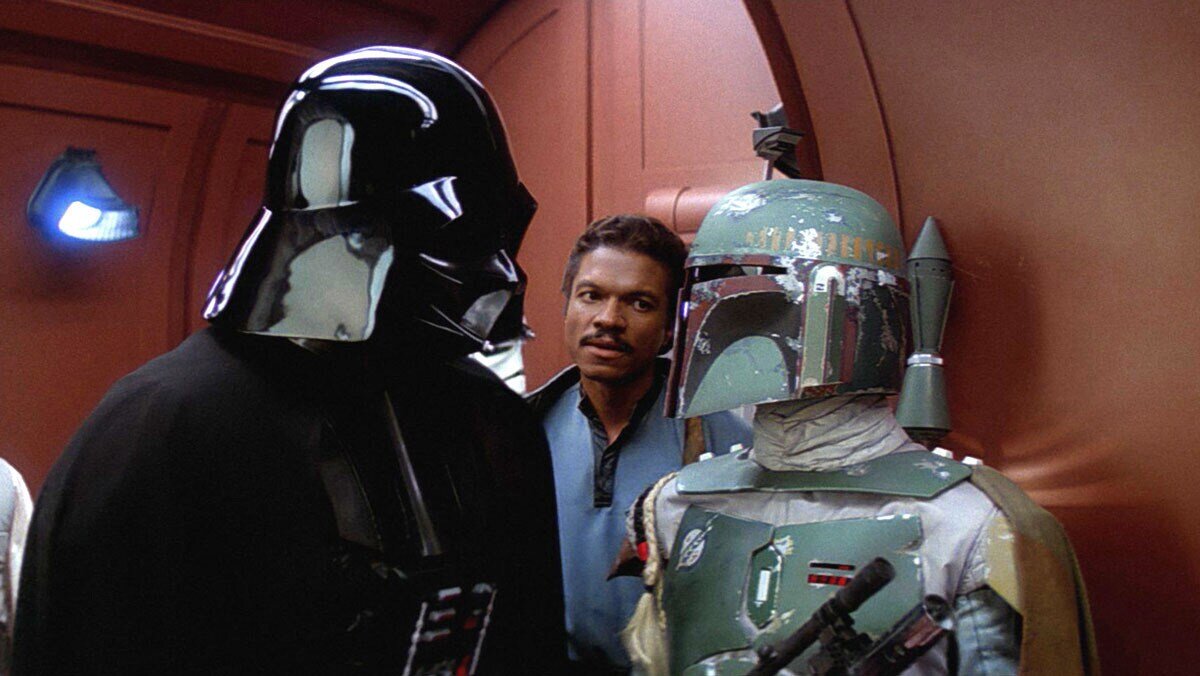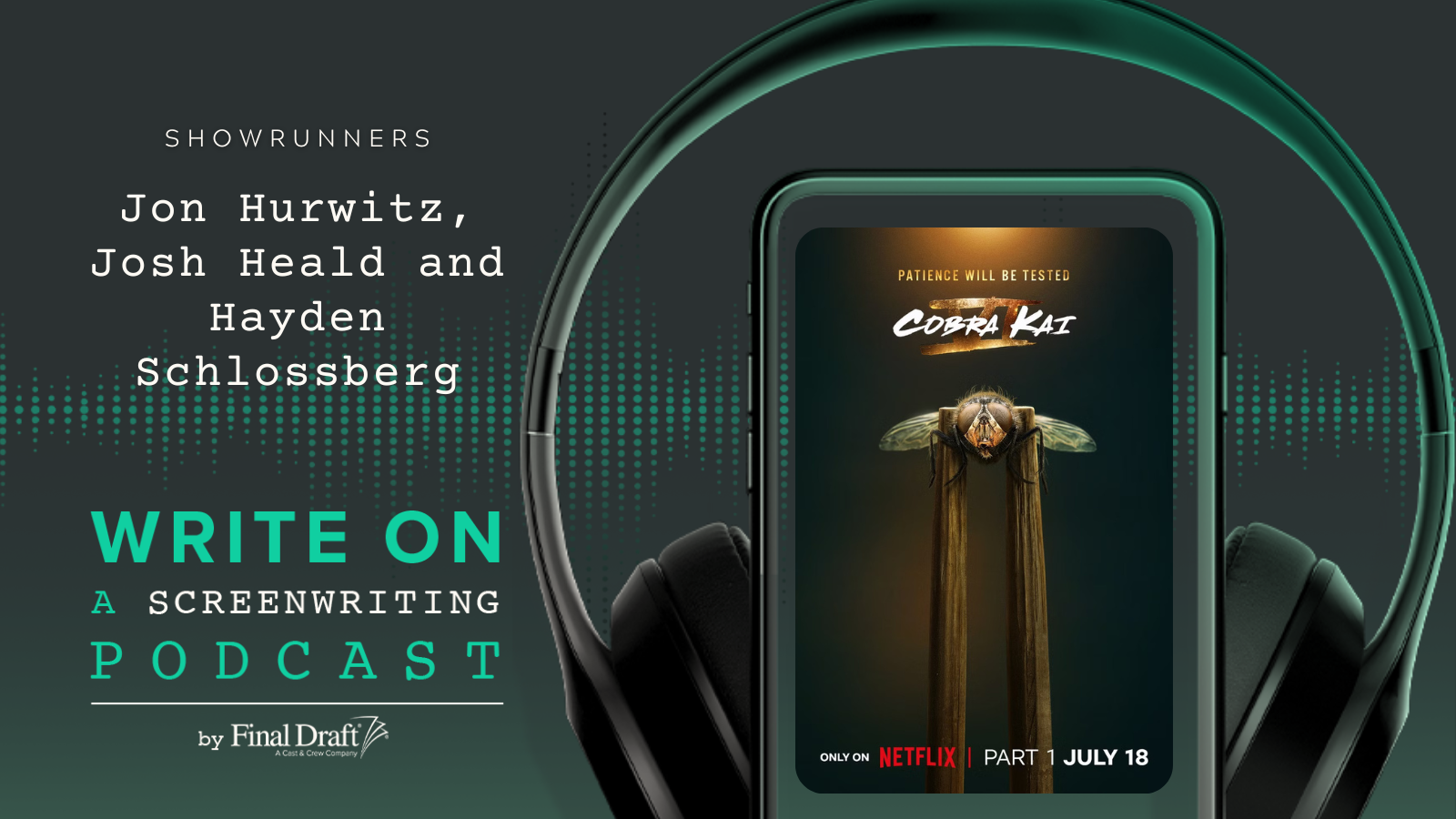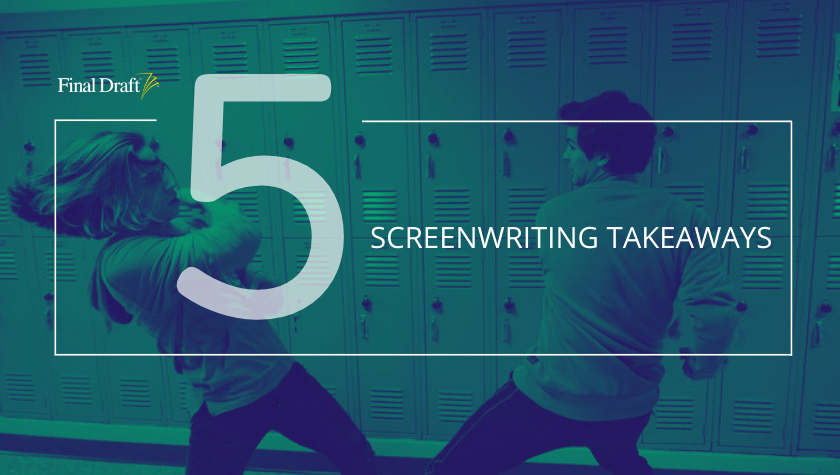5 Screenwriting Takeaways: 'Cobra Kai'
May 22, 2019
The first two seasons of Cobra Kai have been widely praised by fans and critics alike. An extension of The Karate Kid film franchise, the YouTube Premium TV series follows the characters of Daniel LaRusso and Johnny Lawrence as they rekindle their rivalry 34 years after the first film. The show’s success is due not only to a committed cast, but also to the strong writing from series creators Jon Hurwitz, Hayden Schlossberg, and Josh Heald.
Here are five screenwriting takeaways you can learn from the Cobra Kai team.
1. Flip the Script
In one of season one’s most memorable moments, Johnny Lawrence tells one of his students, Eli Moskowitz, that he needs to “flip the script” and not allow himself to be characterized by his deformed lip. Following his Sensei’s advice, Eli flips the script by getting a mohawk – thus earning the nickname “Hawk.” No longer a meek introvert, Hawk slowly becomes one of the most aggressive Cobra Kai students (and eventually a bully).
The show’s creators flipped the script out of the gate by choosing to enter the Cobra Kai story through Johnny’s point of view, rather than Daniel LaRusso‘s (the protagonist of the original film series). Johnny was Daniel’s antagonist and primary rival in the first film. The first few episodes of Cobra Kai are focused on Johnny, who’s living a down-on-his-luck existence in Reseda. He’s never gotten over Daniel defeating him in the All Valley Karate Tournament 34 years ago.
The original film clips are shown — but now with a new slant. The way Johnny sees it, Daniel wasn’t a hero, but some jerk kid who moved in on his girlfriend and humiliated him in front of his peers. To make matters worse, Daniel has lived a charmed life. He owns multiple car dealerships and lives in a large home in Encino with his wife and two children. Johnny, on the other hand, is divorced, estranged from his son, and works as a handyman whenever he can get the work. Johnny spends most of his nights alone in his low-rent apartment, drinking Coors and brooding over the bad turn his life took.
In The Karate Kid, Johnny was just some blond bully. Now, he’s a three-dimensional antihero we sympathize with. Throughout season one, Johnny has a redemptive arc in which he helps a bullied teen, Miguel Diaz, and reopens the Cobra Kai dojo. The antagonist we hated is now the protagonist we’re rooting for. Ask yourself this: Would Cobra Kai be as engaging or well-received if they had replicated the film’s original character dynamic and Johnny was simply Daniel’s nemesis again? When approaching a story, especially one with archetypical characters, consider flipping the script by telling things from a different point of view.
2. Make Your Characters Complicated
At the start of season one, our sympathies lay primarily with Johnny. When Daniel is re-introduced, he comes off as arrogant, and even a bit of a jerk. He’s no longer the underdog of the first film. He’s now a local celebrity and a successful businessman. He’s somebody who’s been getting everything he’s wanted for the past few decades. It would have been easy to keep with this reversed dynamic and make Daniel the villain. But, the creators went in a different and more complicated direction.
Inspired by the reopening of Cobra Kai, Daniel’s passion for karate is rekindled and he decides to establish his own dojo. Daniel considers the Cobra Kai ethos too aggressive and unethical, and he thinks Johnny is a bad influence on his students. Daniel’s dojo will follow the teachings of his sensei Mr. Miyagi, in which karate is used only for defense. Whereas Johnny wants his students to be tough and self-reliant, Daniel wants his students to be peaceful and harmonious with the world that surrounds them. It’s not long before we find our allegiance split between the two characters and we’re rooting for both of them!
Their dueling philosophy comes even more into focus during season two, essentially giving Cobra Kai two protagonists. Johnny and Daniel are both three-dimensional. They’re both flawed and very human. The same thing can be said for the supporting characters. Hawk starts off as a bullied introvert only to become a cocky bully. Miguel Diaz is at heart a good kid, but he becomes more aggressive and hot-headed as Cobra Kai’s star pupil. Tory is a cocksure new pupil in season two who takes to Cobra Kai’s teachings like a fish to water. She becomes Samantha LaRusso, Daniel’s daughter, main rival. But although she’s filling the role of villain, she’s not unsympathetic. Tory comes from a poor background and she views Samantha as a rich girl who’s never been denied anything. Even John Kreese, who’s the closest the series has to an archetypical villain, has another side to him. It’s revealed Kreese is even more down-on-his-luck than Johnny and has been living in homeless shelters for the past 30 years. Kreese’s “no mercy” philosophy stems from someone who views the world as ruthless, unforgiving and believes one must strike at it accordingly. Whether they’re heroes, villains, or walking the thin grey line, giving your characters complexity is a great way to pull the reader or viewer into your story.
3. Honor Your Source Material Without Simply Replicating It
With the industry’s increased focus on established IP, a working writer will most likely get the chance to write a sequel or reboot. In recent years, there have been some that divided fans, and while it’s true, you can’t always please everyone, the difference between writers who are true fans and others who are just working for a paycheck is sometimes painfully clear. Cobra Kai has achieved almost universal acclaim from both new and old fans alike of The Karate Kid films. The series creators have struck just the right balance between subverting the past while also honoring it. Even in season one, when they flip the script on the Daniel/Johnny dynamic, it never comes across as a cheap gimmick or disharmonious with the 1980s films. The trajectory of the characters makes perfect sense. As the series progresses, more characters appear and homages are made, but they never feel forced, and they always reveal a keen knowledge and respect for the films. Even a less popular entry, The Karate Kid Part III, has been referenced a couple of times. This is an expansion of a lived-in world and ultimately, you’re convinced this is simply a continuation. The spirit is there. The characters are there. But we’re getting new stories, new conflicts, and new points of view. Many fans would agree, this is the best way to revisit a beloved property.
4. Conflict. Conflict. Conflict.
This might sound pretty basic, but you’d be surprised how many novice writers ignore the necessity of conflict in their specs. You might want to avoid conflict in real life, but it’s the lifeblood of a compelling story. If everyone is getting along, it might be nice, but it’s also boring. Whether it’s a comedy, a drama, horror or action, you need conflict between your characters. Think of your typical zombie apocalypse storyline; the survivors usually have bigger issues with each other than with the zombies. With Cobra Kai, the writers layered character conflict on top of character conflict on top of character conflict on top of even more character conflict! While the primary character conflict is between Johnny and Daniel, Johnny is also in conflict with his former Sensei, Kreese, who’s attempting to subvert him and take control of Cobra Kai. There’s also conflict between Johnny and his estranged son Robby, who has become Daniel’s pupil. Meanwhile, Daniel is in conflict with his wife Amanda, who thinks her husband is focusing too much on karate and not enough on his day-to-day responsibilities as a husband/father/business owner. Daniel’s daughter Samantha is in conflict with both her ex Miguel and her new rival Tory, who’s now involved with Miguel. Hawk is in conflict with his ex-friend Demetri, who has joined Daniel’s dojo and is a reminder of Hawk’s “nerd” past. In fact, pretty much every teen character who has chosen a side in the larger Johnny/Daniel warring dojo conflict has created a pocket rivalry. This all comes to a brilliant head in the season two finale, resulting in a high school battle royale. Ultimately, we’d like to see Johnny and Daniel settle their differences, but we don’t want it to happen too soon. If Cobra Kai is akin to Johnny’s Dodge Challenger, conflict is the air in its tires and the gas in its tank.
5. Don’t Be Weak… Or A Bully
The final lesson Cobra Kai teaches transcends writing and is an overall philosophy for life. In season one, Johnny teaches his students to not succumb to victimhood and “show no mercy” (which is the credo of his former sensei Kreese). In season two when he starts to see the detrimental effect all this unchained hostility is having on his students, Johnny pulls back and starts teaching his students a less aggressive variation of the Cobra Kai style. He still wants them to be tough — and never a victim — but at the same time, he tells them not to be a bully. If Daniel’s more passive teachings represent one extreme and Kreese’s more violent teachings represent another extreme, Johnny’s greyer and more flexible martial arts philosophy might just emerge as the true path to follow.
You can binge Cobra Kai now on Netflix.
Written by: Edwin Cannistraci
Edwin Cannistraci is a professional screenwriter. His comedy specs PIERRE PIERRE and O’GUNN both sold with more than one A-list actor and director attached. In addition, he’s successfully pitched feature scripts, TV pilots and has landed various assignment jobs for Universal, Warner Bros, Paramount and Disney.- Topics:
- Discussing TV & Film




